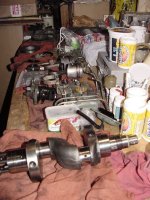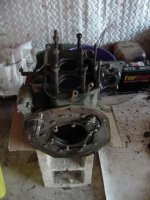I mentioned before that I have a rear motor seal that is leaking. Have man that lives 4 or 5 miles from me, that I thought I might get to do it, as he works on tractors at home for a living. I called him and he said, I don't know but I did a clutch job on a Ferguson last fall, and it cost him $600. And it would probably be that much anyway. So that put it out of the question to me, too much money. I guess I'll have to do it myself. So I need some information. The nut that holds the flywheel on, what size is it? I don't have a metic socket that size I know and will have to rent one, so need to know the size. And how do you hold the flywheel from turning when takeing it off and putting it on, as the book says 275 to 300 ft lbs torque? This will all be new to me, and I'm an old man, but I called the place where I bought the tractor and he said he believed I could do it. But he wasn't sure of the size of the nut. I won't be doing it till it cools off and probably after I get through cutting grass this fall, as I need it and if I run into a problem, I don't want to hurry it, I want it to be right the first time, not have to do it over. I hope I can also rent a torque wrench that will go that high, probably have to be 3/4 inch drive. OK thanks for the answers, even before I get them. /forums/images/graemlins/confused.gif
You are using an out of date browser. It may not display this or other websites correctly.
You should upgrade or use an alternative browser.
You should upgrade or use an alternative browser.
Need help
- Thread starter pruntyc
- Start date
- Views: 4747
/ Need help
#1
normde2001
Elite Member
- Joined
- Mar 10, 2002
- Messages
- 4,163
Thanks to our Chinese neighbors, who know the real price of tools, you can purchase a 3/4" breaker bar, and large size sockets for almost nothing at Northern tool, Harbor Freight, etc. Not pro quality, but good enough for our uses. As far as a torque wrench goes, for 275-300ft/lbs, fergidaboudit, just tighten the sucker with that 15$ 3/4 breaker bar. Unless you are doing a head or intake manifold torque specs don't mean much. I have worked on dozens of engines, motorcycle, lawn mower, auto, without using a torque wrench except for head and intake manifold.
gbirky
Platinum Member
- Joined
- Mar 25, 2002
- Messages
- 640
- Location
- Near Hagerstown, MD
- Tractor
- Yanmar models: YM1110D, YM1301D
Are you talking about the flywheel or the front crankshaft pulley? My YM1110D has six bolts that hold the flywheel onto the crankshaft, but a single nut holds the front pulley on.
As far as holding the engine from turning when removing or installing that big nut - I used a piece of chain with one end fastened to the flywheel with one of the clutch bolts, the other end secured to a bolt on the engine block. I also didn't use a torque wrench when tightening that big nut.
As far as holding the engine from turning when removing or installing that big nut - I used a piece of chain with one end fastened to the flywheel with one of the clutch bolts, the other end secured to a bolt on the engine block. I also didn't use a torque wrench when tightening that big nut.
gbirky
Platinum Member
- Joined
- Mar 25, 2002
- Messages
- 640
- Location
- Near Hagerstown, MD
- Tractor
- Yanmar models: YM1110D, YM1301D
Dick,
So you do have a big nut holding the flywheel on. My advice still applies. I used a piece of chain to keep the engine from turning over. I had to do this also when I removed the gear from the crankshaft on the front of the engine.
Once you have split the tractor and removed the clutch assembly from the flywheel, use a piece of chain. Attach one end to the flywheel with one of the clutch attaching bolts (this should be near the outter edge of the flywheel). Run the chain around the side of the flywheel to a convenient bolt on the engine block. I used one of the bolts that attach the engine block to the bellhousing. I didn't even use a socket to remove the front crank gear - I used what the mechanics at work call a "spud wrench" with a "cheater bar". The spud wrench looks just like a pipe wrench, except it has no teeth on the jaws, just flat smooth surfaces. The cheater bar was just a 2ft length of pipe slid over the handle of the spud wrench.
Remember - a 200lb man on the end of a 2ft wrench is 400ft-lb. If you only weigh 150lb, then you need a 2'8" long wrench.
So you do have a big nut holding the flywheel on. My advice still applies. I used a piece of chain to keep the engine from turning over. I had to do this also when I removed the gear from the crankshaft on the front of the engine.
Once you have split the tractor and removed the clutch assembly from the flywheel, use a piece of chain. Attach one end to the flywheel with one of the clutch attaching bolts (this should be near the outter edge of the flywheel). Run the chain around the side of the flywheel to a convenient bolt on the engine block. I used one of the bolts that attach the engine block to the bellhousing. I didn't even use a socket to remove the front crank gear - I used what the mechanics at work call a "spud wrench" with a "cheater bar". The spud wrench looks just like a pipe wrench, except it has no teeth on the jaws, just flat smooth surfaces. The cheater bar was just a 2ft length of pipe slid over the handle of the spud wrench.
Remember - a 200lb man on the end of a 2ft wrench is 400ft-lb. If you only weigh 150lb, then you need a 2'8" long wrench.
Well, I weigh 207, so I am heavy enough. But I was not going to remove the clutch from the flywheel. As it seems to be in great shape. Not a problem, you know if it ain't broke, don't fix it. The guy at the tractor shop told me to use a deep well socket, he wasn't sure if it was 36 o 37 mm. Don't know why a deep well, but that is what he said. I was hopeing some of these guys that do it all the time, would tell me. Don't get me wrong, I am grateful, for your help, but I think I have a different problem than yours was. As the engine is made different. Glad I don't plan on doing it this week as not getting the help yet, that I'm hopeing for. There must be someway that the shops use to hold the flywheel, when they don't take the clutch off of it. I think you said you didn't take the lines loose from the hydraulic pump either. I don't think that will work with this engine either. It kind of sticks in to the front and dont' think I could get it to clear the side.
gbirky
Platinum Member
- Joined
- Mar 25, 2002
- Messages
- 640
- Location
- Near Hagerstown, MD
- Tractor
- Yanmar models: YM1110D, YM1301D
Actually, you don't need to remove the clutch from the flywheel to put the chain on. You can put the chain on with the clutch in place. Just use a longer bolt so that you catch enough threads. I don't have a parts manual for the 1700 or 2000, so I can't say why they said to use a deep well socket, but I would guess it is because the nut is recessed in the flywheel. Come to think of it, it may not be possible to get at that nut without removing the clutch. I know I couldn't have removed the flywheel with the clutch in place. By the way, clutches aren't that expensive. I know you are on a limited budget, but replacing the clutch while you already have the tractor split is alot easier than having to split it again to replace the clutch later.
As for the hydraulic pump - I understand your problem. I did have to move things around a bit after the two halves were separated in order to clear the hydraulic pump around the engine block. In my case it was pretty easy since the tractor is very small. But disconnecting the hydraulic pump is no big deal anyway - you can clean the hydraulic screen and replace the fluid while you have the hydraulic system apart.
I agree, I'd like to hear from the guys who do this all the time. How do you keep the engine from turning over when you remove that nut???
As for the hydraulic pump - I understand your problem. I did have to move things around a bit after the two halves were separated in order to clear the hydraulic pump around the engine block. In my case it was pretty easy since the tractor is very small. But disconnecting the hydraulic pump is no big deal anyway - you can clean the hydraulic screen and replace the fluid while you have the hydraulic system apart.
I agree, I'd like to hear from the guys who do this all the time. How do you keep the engine from turning over when you remove that nut???
gbirky
Platinum Member
- Joined
- Mar 25, 2002
- Messages
- 640
- Location
- Near Hagerstown, MD
- Tractor
- Yanmar models: YM1110D, YM1301D
gbirky
Platinum Member
- Joined
- Mar 25, 2002
- Messages
- 640
- Location
- Near Hagerstown, MD
- Tractor
- Yanmar models: YM1110D, YM1301D
Here's another shot. This is of the rear of the engine block after I removed the crankshaft. You can see the holes around the edge of the back plate where it mounts to the bellhousing. I used one of these holes to attach one end of the chain to hold the flywheel and crankshaft from turning.
Attachments
clifst2310
Silver Member
- Joined
- Mar 10, 2002
- Messages
- 142
- Location
- Bonnieville Ky
- Tractor
- Yanmar 2310 and IH 3414 w/loader and 3100 backhoe
I have another way to hold the flywheel. In the 70's I worked on VW's and used a device called a flywheel lock. It is a piece of metal with teeth to engage the flywheel teeth and a hole where you bolt it to an engine block mounting hole. This keeps the flywheel from turning. Also just take a ruler and measure accross the flat surfaces of the nut and you have the required socket size. I still have the 36 mm socket for VW flywheels. This works out to 1-7/16 sae. If my memory serves me they were tightened to 220 ftlbs. To break a nut that big I used a 6 foot pipe sliped over the breaker bar. I put the pipe nearly horizontal and lifted myself. Before I got all my weight on the bar the nut loosens. 200lbs X 6 feet is 1200 ftlbs. I'm yet to see any flywheel nut that tight. I have also loosened the front primary drive on big harley engines and really stubborn lugnuts this way.

